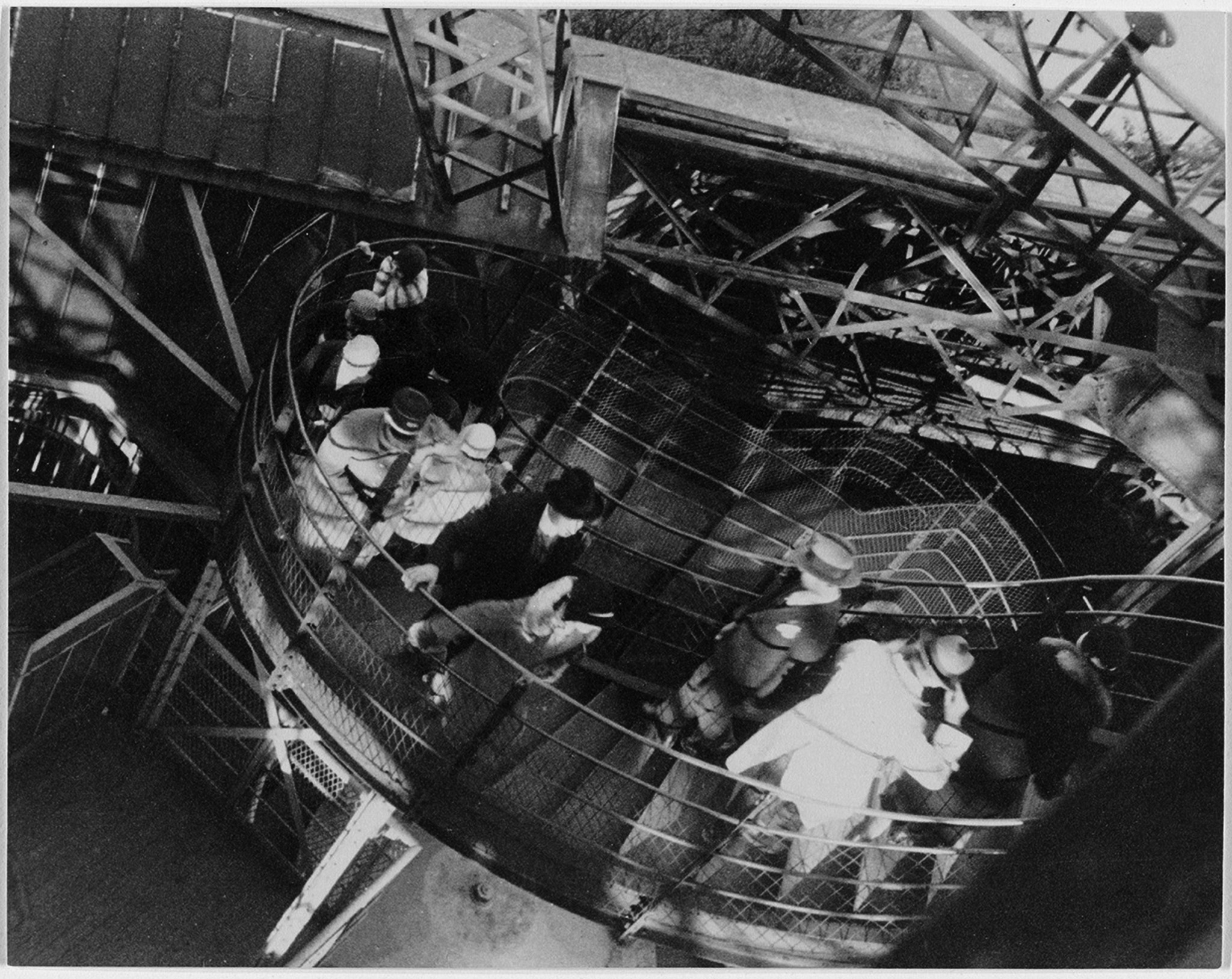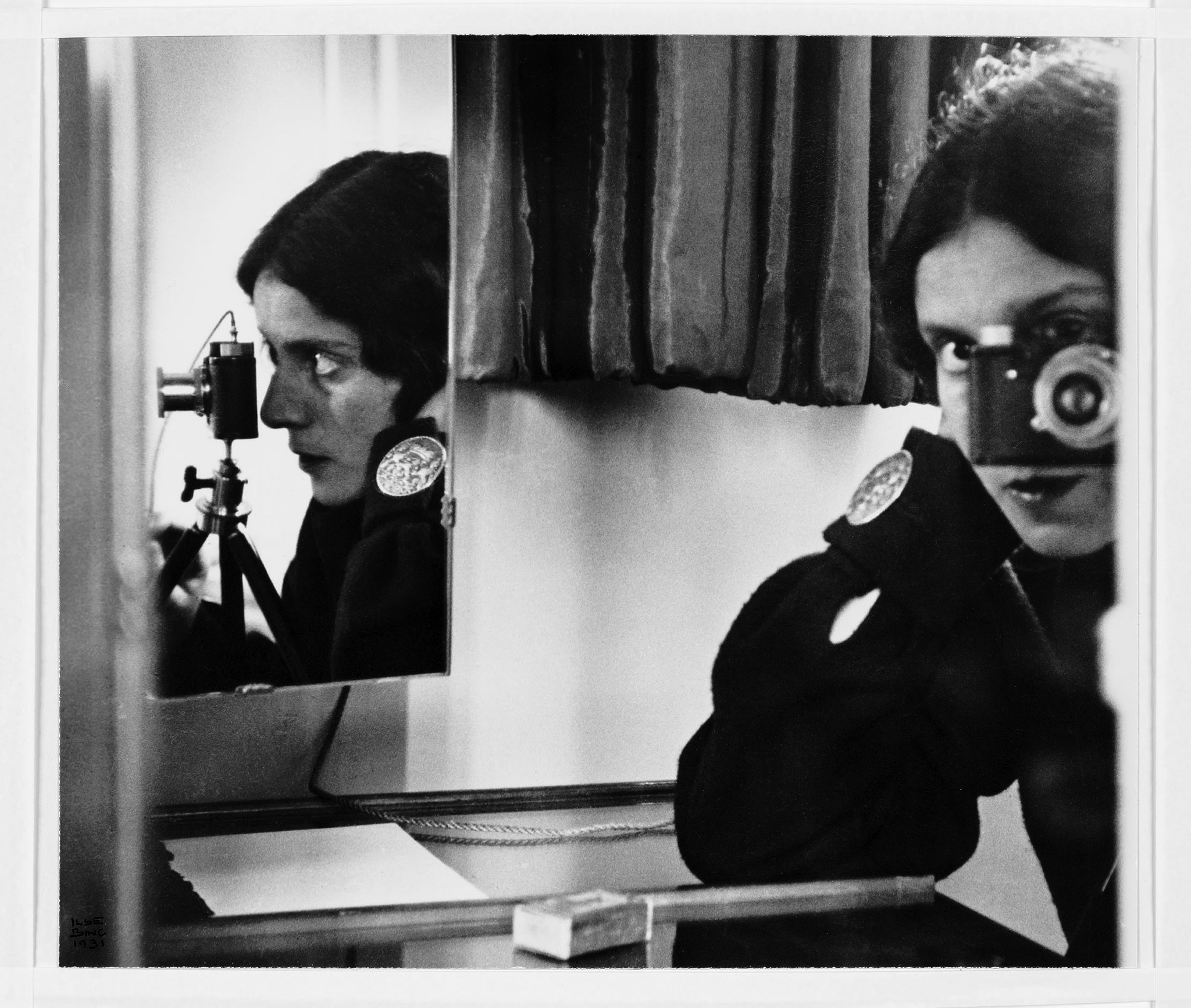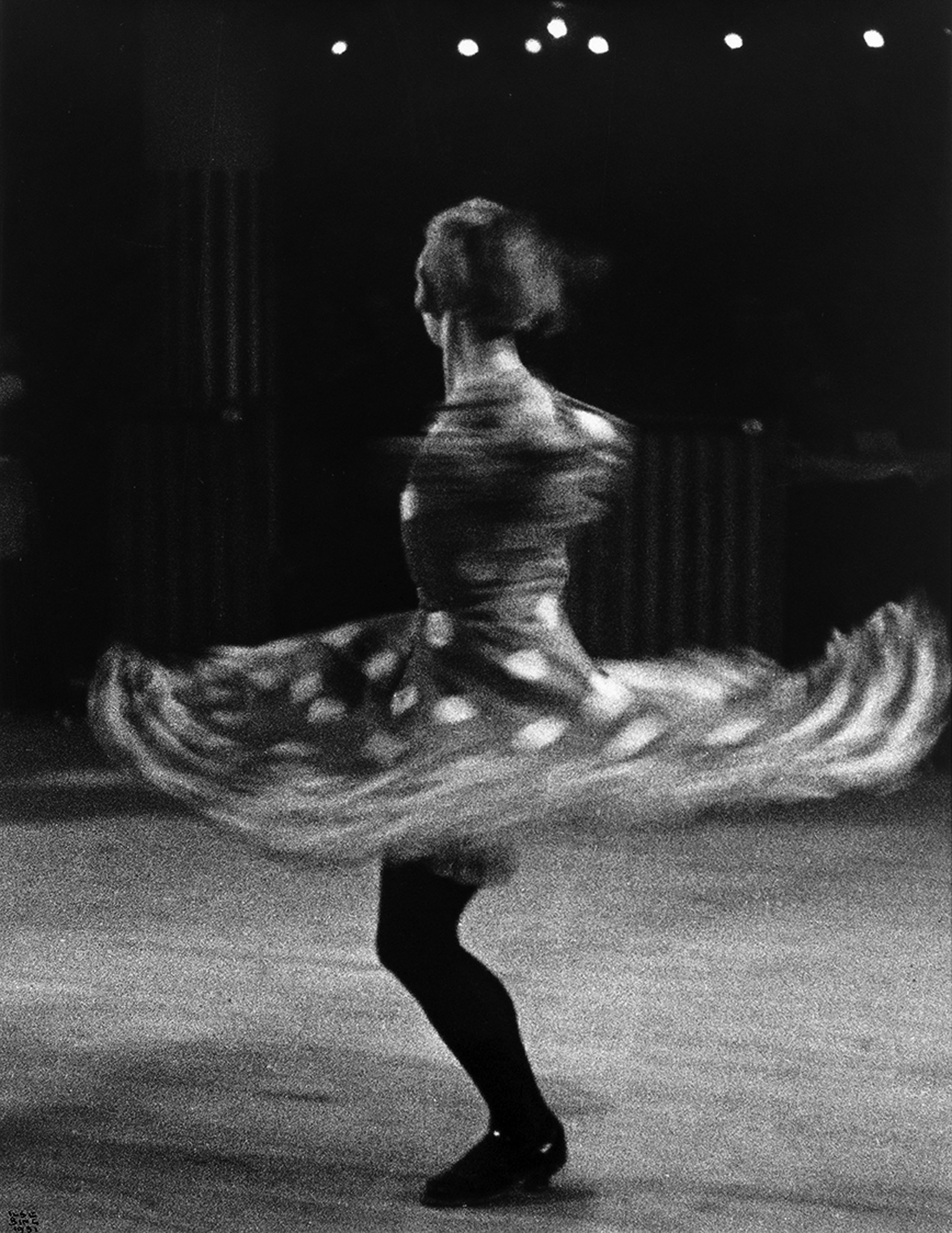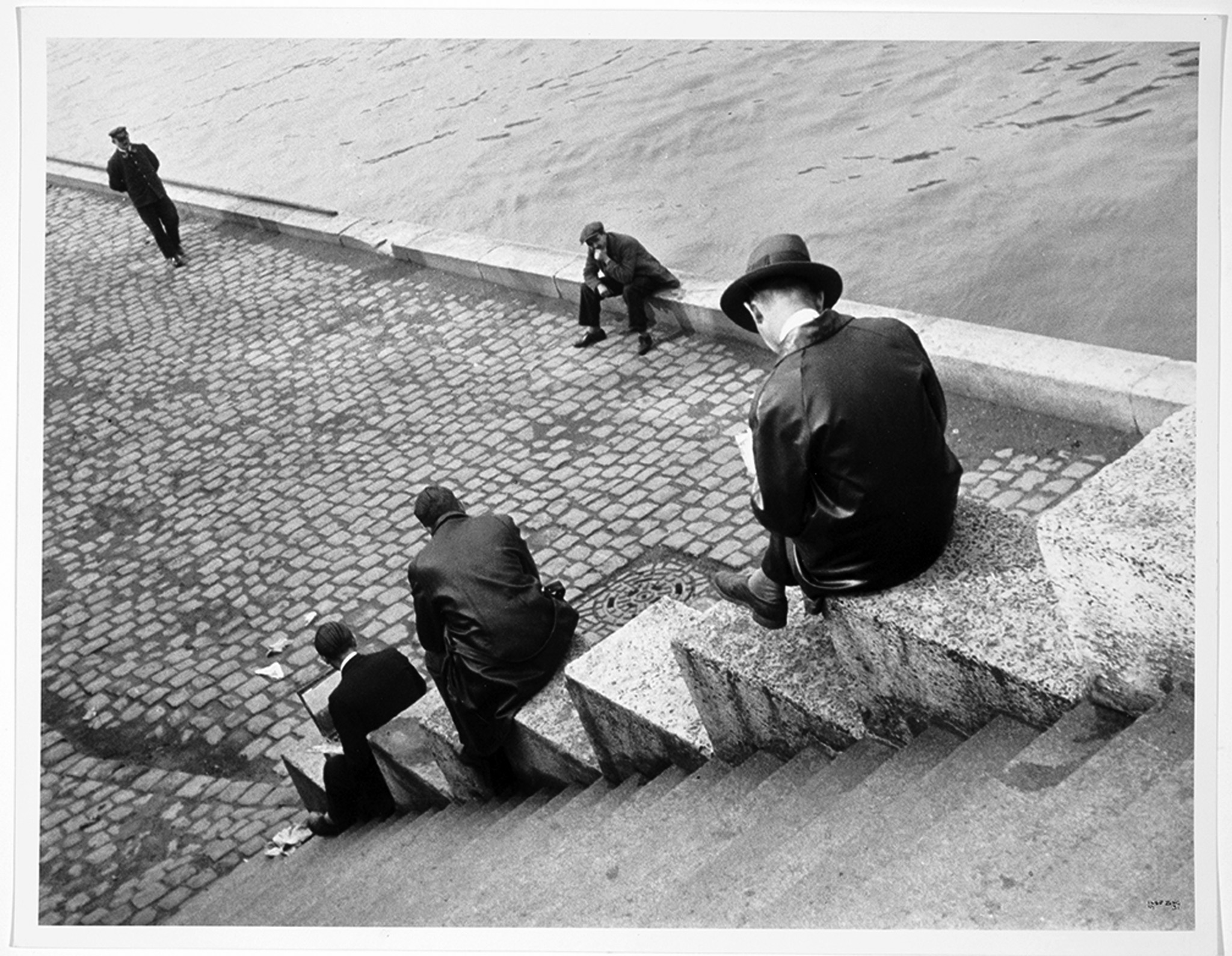Like her contemporary Berenice Abbott, whose work was also presented to the Foundation three years ago, Ilse Bing applied knowledge of her time to show how to look at modern architecture: in Paris focusing on the Eiffel Tower, focusing on the abstract geometry of her construction and in the moving mass flows of visitors; after her in New York, like all the outsiders of her, with an absorbed gaze on the skyscrapers of the city, with a critical vision. A look that also captured the humblest neighbourhoods, crossing from iconic visions to the always-forgotten areas where most urban dwellers live.

Ilse Bing. “Feia molt de vent a la Torre Eiffel / It was so Windy on the Eiffel Tower”, Paris. 22,2 x 28,2 cm. The Art Institute of Chicago, Julien Levy Collection. Gift of Jean and Julien Levy (1977.195).
Estate of Ilse Bing.
Ilse Bing's artistic trajectory is marked in part by the cities in which she lived, Frankfurt before the 1930s, Paris in that decade, and post-war New York, where she basically experienced her condition as an exile. However, it is not possible to ascribe her work to any of the photographic or cultural currents that she knew, although she draws on all of them. Her work is influenced by Moholy-Nagy's Das Neue Sehen (the New Vision), by the Bauhaus of the Weimar Republic, and by André Kertész, as well as by the surrealism of Man Ray.
Ilse Bing belonged to a generation of female photographers who, for the first time, were achieving some visibility in the world of arts and culture.
Four keys to a visit
The Bauhaus.
Starting in 1910, the city of Frankfurt became a prototype of modern urbanism thanks to the architect Ernst May, as he began to put aside its medieval layout in favour of a transformation that would meet different social needs. The new architecture soon echoed the ideas of El Lissitzky's constructivism, to some extent through the Dutch architect Mart Stam, a friend of Ilse Bing. This and the theories of the Bauhaus had a great impact on the work of the photographer. László Moholy-Nagy, one of the professors at that institution, had promoted the union of architecture and photography, as well as the independence of the medium from painting. The possibilities of Das Neue Sehen (the New Vision) could be endless. Ilse Bing took advantage of them, applying some of them to her work: abstraction, close-ups, high-angle shots, low-angle shots, photomontages or overprints.

Ilse Bing, Self-portrait with Leica, 1931. 26,5 × 30,7 cm. Collection of Michael Mattis and Judith Hochberg, New York. Estate of Ilse Bing. Photograph by Jeffrey Sturges.
Surrealism, the spirit of an age.
When Ilse Bing settled in Paris in 1930, the city was a hotbed of artistic and intellectual trends, where some of the key movements for the development of the avant-garde emerged. Among them, one of the ones that most influenced the artist was surrealism, whose echoes can be seen in the images she took of different objects for fashion magazines, as they correspond to surrealist theories on fetishism, and in the framing, she made by capturing chairs, streets or public spaces, which convey a feeling of strangeness, almost of alienation. This influence is also evident through her relationship with relevant figures of this trend, such as Elsa Schiaparelli.

Ilse Bing. French Can-Can Dancer, 1931. 35,6 x 27,9 cm. Printed 1941. Galerie Karsten Greve. St. Moritz / Paris / Köln. Estate of Ilse Bing.
The movement.
Despite her fascination with abstraction and pure compositions, as evidenced in many of her still-life and architectural photographs, Ilse Bing was a keen photographer of the dynamic and movement of life, of changing reality. She demonstrates this in the photographs of the Moulin Rouge and its surroundings and in the investigations that she did around the dance. She captured the whirling dynamism of the dancers with their skirts, but also the expressiveness of bodies in full motion, at the moment of jumping into the air or doing a split.

Ilse Bing. Three Men Sitting on the Steps by the Seine. 27,9 × 35,6 cm. International Center of Photography, New York. Gift of Ilse Bing, 1991 (16.1991). Estate of Ilse Bing.
Woman photographer.
Ilse Bing was part of a generation of female photographers who achieved hitherto unprecedented visibility. It was not natural for women to be artists, and generally, this field was occupied exclusively by men, who looked with disdain, even animosity, at the presence of women in the social and cultural sphere. For Bing, as for many of his contemporaries—Germaine Krull, Florence Henri, Laure Albin-Guillot, Madame d'Ora, Berenice Abbott, Nora Dumas, and Gisèle Freund—, the camera became an essential tool for self-determination and a way to confirm their own identity.

Ilse Bing. “Feia molt de vent a la Torre Eiffel / It was so Windy on the Eiffel Tower”, Paris. 22,2 x 28,2 cm. The Art Institute of Chicago, Julien Levy Collection. Gift of Jean and Julien Levy (1977.195).
Estate of Ilse Bing.
Ilse Bing's artistic trajectory is marked in part by the cities in which she lived, Frankfurt before the 1930s, Paris in that decade, and post-war New York, where she basically experienced her condition as an exile. However, it is not possible to ascribe her work to any of the photographic or cultural currents that she knew, although she draws on all of them. Her work is influenced by Moholy-Nagy's Das Neue Sehen (the New Vision), by the Bauhaus of the Weimar Republic, and by André Kertész, as well as by the surrealism of Man Ray.
Ilse Bing belonged to a generation of female photographers who, for the first time, were achieving some visibility in the world of arts and culture.
Four keys to a visit
The Bauhaus.
Starting in 1910, the city of Frankfurt became a prototype of modern urbanism thanks to the architect Ernst May, as he began to put aside its medieval layout in favour of a transformation that would meet different social needs. The new architecture soon echoed the ideas of El Lissitzky's constructivism, to some extent through the Dutch architect Mart Stam, a friend of Ilse Bing. This and the theories of the Bauhaus had a great impact on the work of the photographer. László Moholy-Nagy, one of the professors at that institution, had promoted the union of architecture and photography, as well as the independence of the medium from painting. The possibilities of Das Neue Sehen (the New Vision) could be endless. Ilse Bing took advantage of them, applying some of them to her work: abstraction, close-ups, high-angle shots, low-angle shots, photomontages or overprints.

Ilse Bing, Self-portrait with Leica, 1931. 26,5 × 30,7 cm. Collection of Michael Mattis and Judith Hochberg, New York. Estate of Ilse Bing. Photograph by Jeffrey Sturges.
Surrealism, the spirit of an age.
When Ilse Bing settled in Paris in 1930, the city was a hotbed of artistic and intellectual trends, where some of the key movements for the development of the avant-garde emerged. Among them, one of the ones that most influenced the artist was surrealism, whose echoes can be seen in the images she took of different objects for fashion magazines, as they correspond to surrealist theories on fetishism, and in the framing, she made by capturing chairs, streets or public spaces, which convey a feeling of strangeness, almost of alienation. This influence is also evident through her relationship with relevant figures of this trend, such as Elsa Schiaparelli.

Ilse Bing. French Can-Can Dancer, 1931. 35,6 x 27,9 cm. Printed 1941. Galerie Karsten Greve. St. Moritz / Paris / Köln. Estate of Ilse Bing.
The movement.
Despite her fascination with abstraction and pure compositions, as evidenced in many of her still-life and architectural photographs, Ilse Bing was a keen photographer of the dynamic and movement of life, of changing reality. She demonstrates this in the photographs of the Moulin Rouge and its surroundings and in the investigations that she did around the dance. She captured the whirling dynamism of the dancers with their skirts, but also the expressiveness of bodies in full motion, at the moment of jumping into the air or doing a split.

Ilse Bing. Three Men Sitting on the Steps by the Seine. 27,9 × 35,6 cm. International Center of Photography, New York. Gift of Ilse Bing, 1991 (16.1991). Estate of Ilse Bing.
Woman photographer.
Ilse Bing was part of a generation of female photographers who achieved hitherto unprecedented visibility. It was not natural for women to be artists, and generally, this field was occupied exclusively by men, who looked with disdain, even animosity, at the presence of women in the social and cultural sphere. For Bing, as for many of his contemporaries—Germaine Krull, Florence Henri, Laure Albin-Guillot, Madame d'Ora, Berenice Abbott, Nora Dumas, and Gisèle Freund—, the camera became an essential tool for self-determination and a way to confirm their own identity.






























![Brassaï. Montmartre. 1930-31. 29.8 x 39.6 cm [Paris de jour 472.C] Estate Brassaï Succession, Paris. © Estate Brassaï Succession, Paris Brassaï. Montmartre. 1930-31. 29.8 x 39.6 cm [Paris de jour 472.C] Estate Brassaï Succession, Paris. © Estate Brassaï Succession, Paris](/sites/default/files/styles/mopis_home_news_category_slider_desktop/public/lead-images/metaloucs_brassai_estate-brassai-succession-paris_01p.jpg?h=3b4e7bc7&itok=le_IlsBR)






